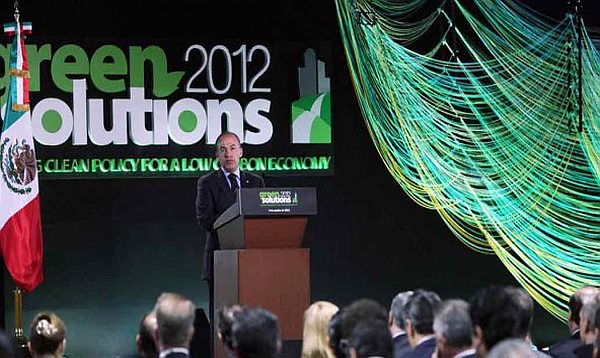Mexico City, Mexico – A biodegradable, non-stick gum that won’t sully sidewalks and trash cans made of "natural plastic" were some of the products on display at the just-concluded 2012 Green Solutions Forum, held in Mexico City. The forum's ambition was to seek ways of combating climate change.
"Traditional chewing gum varieties are petroleum-derived polymers. You throw them on the sidewalk and they stick," states Gerardo Ramirez, representative of Consorcio Chiclero, a group comprising dozens of organizations that extract gum from the Mexican rainforest. Biodegradable gum, by contrast, "gradually disintegrates" under identical environmental conditions, he said.
 |
Consorcio Chiclero was one of more than 100 organizations that took part in the forum, where public and private sector firms, experts and academics showcased their initiatives to combat climate change and promote economic development.
Only 2 percent of the chewing gum currently consumed worldwide is of natural origin, Ramirez said, noting that most varieties, in addition to being a potential eyesore in cities, contribute to an increase in the carbon footprint and greater dependence on fossil-fuel resources.
"It’s important to return to natural consumption," said the head of Consorcio Chiclero, the coordinating body for around 50 cooperatives and chewing gum harvesters whose raw material is extracted from the chicozapote tree. The tree grows abundantly in the tropical forests of the southeastern Mexican states of Quintana Roo and Campeche.
"Harvesting the gum causes no environmental damage and the consortium, which is made up of 2,000 independent gum harvesters, also carries out reforestation projects. Their ancestors were known as 'conscientious guardians' of the forest," he said.
Although 70 percent of Consorcio Chiclero’s production is sold as raw material and just 20 percent is used to make the Chicza brand of chewing gum, that product is currently being exported to more than 15 countries. The ultimate goal is to dedicate all production to that end.
Another product showcased at the green forum was a garbage can made of sugarcane, an eco-friendly product whose manufacture reduces CO2 emissions by 85 percent, Renaud Miniaou, the Plastic Omnium firm’s commercial manager for northern Mexico, told reporters.
"Instead of a making a petroleum based product, we plant sugarcane in Brazil, transform it into ethanol, later into polymer and then into plant-based polyethylene that is injected into the molds used for traditional trash cans," he said.
Demand has exceeded expectations since the product was first marketed in late 2011, according to Miniaou, who said the material’s technical characteristics are identical to fossil-based plastic but it does not contain petroleum, is renewable and eco-friendly.
"The challenge was to make a product identical to what we traditionally had. Eventually the research team pulled it off, and this product has the same technical and physical characteristics as our other containers," he said.
The forum, which ended Wednesday, also was a showcase for academic projects such as eco-friendly bricks and tiles presented by a group of students from the Carlos Carrillo high school in the Gulf coast city of Veracruz.
Using mud and recycled paper, those students developed a new construction material designed to meet the needs of low-income families.
"The advantage of eco-friendly tiles and bricks is that normally there are places where there’s not enough money to buy flooring, the people live on dirt floors. We thought of a way to save paper and help these economies," 18-year-old project advisor Silvia Eugenia Lugo said.
Distinguished attendees at this year’s forum, which focused on sustainable urbanism and green financing, included Mexico’s Mario Molina, a co-recipient of the 1995 Nobel Prize in Chemistry for his work in atmospheric chemistry, "particularly concerning the formation and decomposition of ozone;" and Thomas Kerr of the World Economic Forum.
According to the latest report from the United Nations’ Intergovernmental Panel on Climate Change, published in 2007, temperatures will rise this century by between 1.8 and 6.4 degrees and sea levels will rise by between 7 and 23 inches, causing serious environmental, economic and social impacts.


